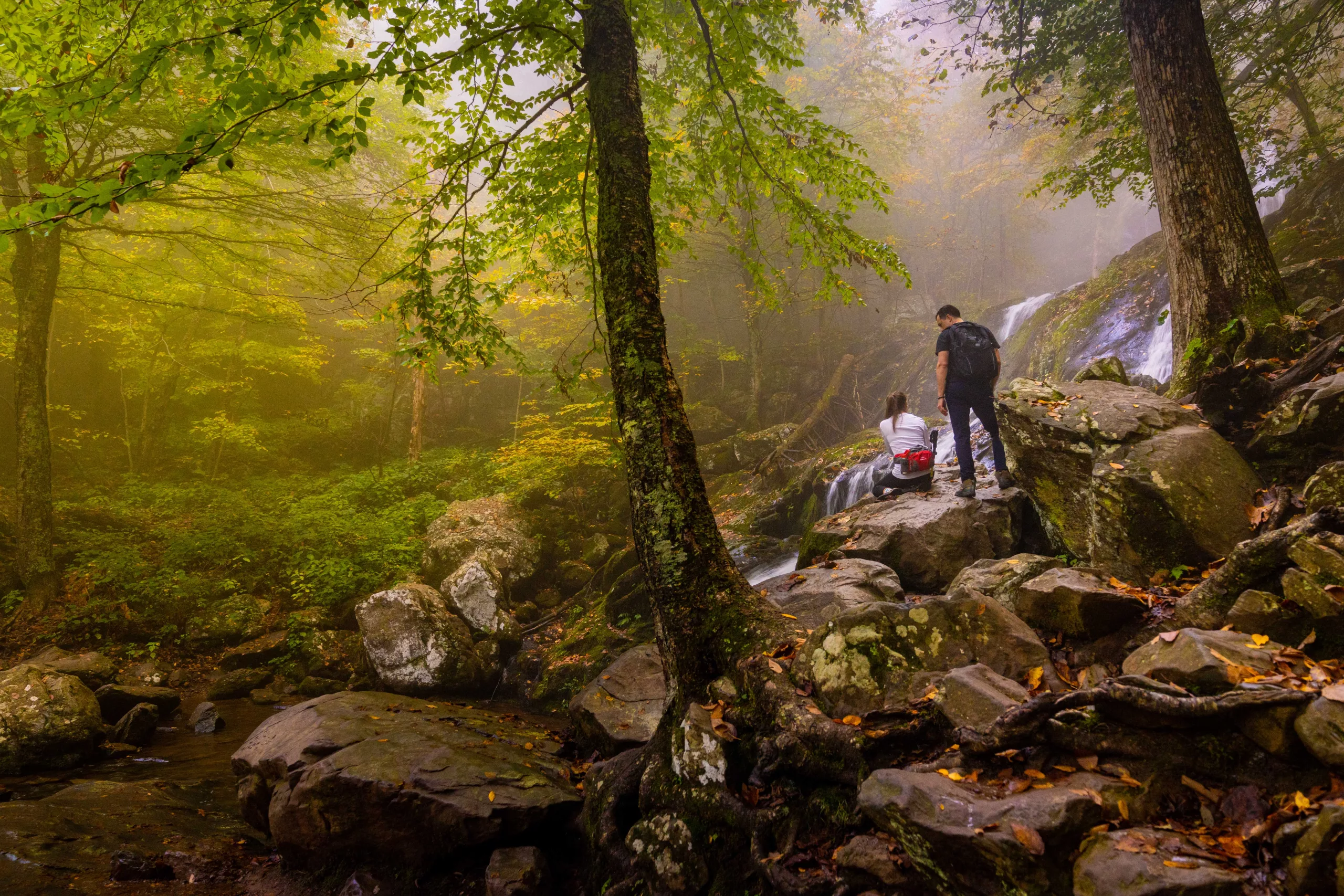Created with leadership from board and staff and input from members and supporters throughout the region, The Piedmont Environmental Council’s 2023-2028 Strategic Plan sets a direction for the years ahead. It articulates a mission statement that reflects the full breadth of our work, a vision for the Virginia Piedmont, and four key focus areas outlining how we will both continue and enhance our efforts.
For more information and downloads, visit pecva.org/strategicplan.
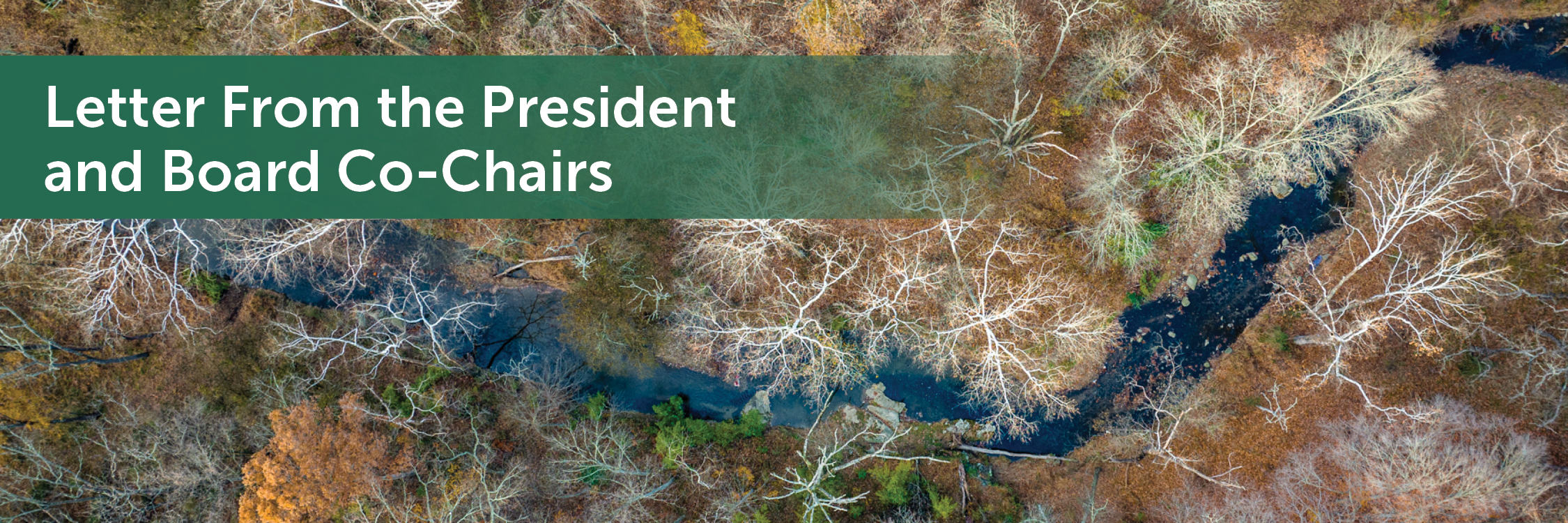
In 1972, sprawl was on a seemingly inevitable course across the eastern seaboard. The women and men who founded The Piedmont Environmental Council were determined to develop a mechanism to shape a better future for the region. Since then, this organization has developed a set of conservation and community engagement strategies that have helped make the Virginia Piedmont a model for sustainable growth and protection of natural, agricultural and historic resources. At the core of our approach is a focus on educating, engaging and empowering residents to effect positive change in their communities.
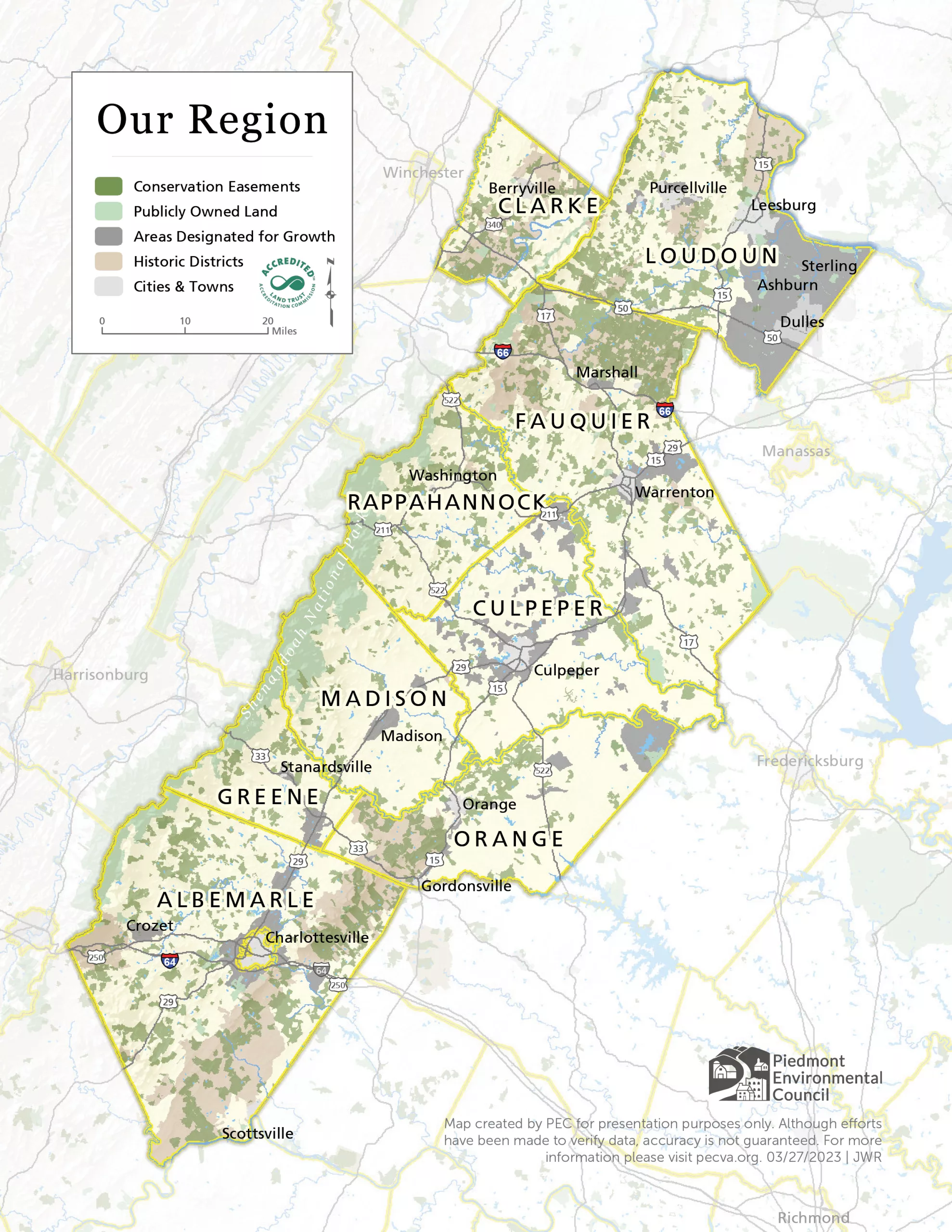
Today in our nine counties, 25% of lands – more than 580,000 acres – are permanently protected, most through conservation easements on private lands. We are more than halfway toward a long-held organizational goal of seeing more than 1 million acres conserved in this extraordinary region. Local governments throughout the Virginia Piedmont have some of the strongest land use zoning and rural protections in the state, guiding growth toward towns and villages while protecting farmland and forests. The work of the Coalition for Smarter Growth, a division of The Piedmont Environmental Council working in the Washington, D.C. region, continues to advance the development of livable, walkable communities oriented around investments in transit, trails, and other transportation infrastructure and amenities.
PEC is a central catalyst for shaping positive change in our region. We take a comprehensive, high-level view of trends in policy, economics, and social change, while working in our communities at the most granular level. We work as a land trust with individual landowners on conservation and as an advocate with neighbors and local partners on local land use planning and policy. We also serve as policy experts, providing advice to local, state, and federal agencies, utilities, and businesses on the impacts of major policy, permitting and investment decisions. We are present and active in the many local and state decisions that affect the Virginia Piedmont region. We are relentless in the pursuit of a sustainable and resilient future.
As much as we have accomplished, the next five years will pose a set of challenges and opportunities of unprecedented complexity. These include significant changes in land use patterns due to new trends in energy and information technology, as well as residential, commercial and industrial development pressures. At the same time, increased public funding for farmland protection, improved water quality and climate resilience provide a tremendous opportunity to accelerate land conservation. PEC’s Board of Directors and staff have developed this strategic plan to guide our course and address these challenges and opportunities to conserve the Piedmont and make it an even better place.
Sincerely,
Christopher G. Miller, President
Jeannie Perin, Board Co-Chair
George L. Ohrstrom II, Board Co-Chair
Our Mission
Protect and restore the lands and waters of the Virginia Piedmont, while building stronger, more sustainable communities.
Our Vision
We envision a Virginia Piedmont where people act on a belief that conservation is essential to creating and maintaining vibrant, healthy communities. Our region is characterized by connected natural and cultural landscapes, thriving villages, towns and cities, clean rivers and streams, and working farms and forests. It’s a beautiful place where residents across all walks of life participate in decisions about its future.
Our Core Values
The Virginia Piedmont is our home. We value this region’s people and lands, its history and culture, its beauty and its future. Work we do beyond our nine counties and at the state and federal levels is guided by our broad perspective on land uses, watersheds and ecosystems that ultimately affect this region.
We value a thoughtful and holistic approach to addressing the complex issues facing our lands and our communities. Being both idealistic and pragmatic, we consider the best data and research, look for unintended consequences, and pursue creative solutions, always guided by our commitment to a sustainable future for the Virginia Piedmont.
We value the broad experiences, opinions and motivations of the Virginia Piedmont’s diverse communities. We are grassroots and nonpartisan, striving to understand on-the-ground policy impacts that help us deliver practical, fair and just solutions to real-world problems.
We value collaboration and partnership. Our success depends on long-term trust, mutual respect and strong relationships with others at the local, regional, state and national level. We are proud to lead when appropriate and take a supportive role when others are better suited to the issue at hand.
We value the power of community engagement. We believe that local decisions matter and that informed and involved communities are vital to achieving positive outcomes. PEC acts as a catalyst and source of inspiration by equipping people with the tools and information they need to mobilize.
We value public access to nature. Fresh air, clean water, and outdoor recreation are critical to the health and well-being of individuals and communities. Access also fosters a deeper appreciation for the earth and its systems, and is critical to achieving a widespread conservation ethic.
We value a strong rural economy. Agriculture and forestry are paramount for a resilient, healthy Virginia Piedmont. Without intentional planning and programs that recognize the value of open space and strength of the many industries it supports, the Virginia Piedmont will lose its local food systems, clean waters, wildlife, ecosystems and climate resilience.
We value smart growth that respects natural and cultural resources. Well-planned towns, cities and villages are characterized by diverse housing options, nature-filled outdoor spaces, and walkable and bike-friendly connections to services, recreation and work. We believe that decisions about housing, water, energy, transportation and economic development must be made with an eye toward sustainability.
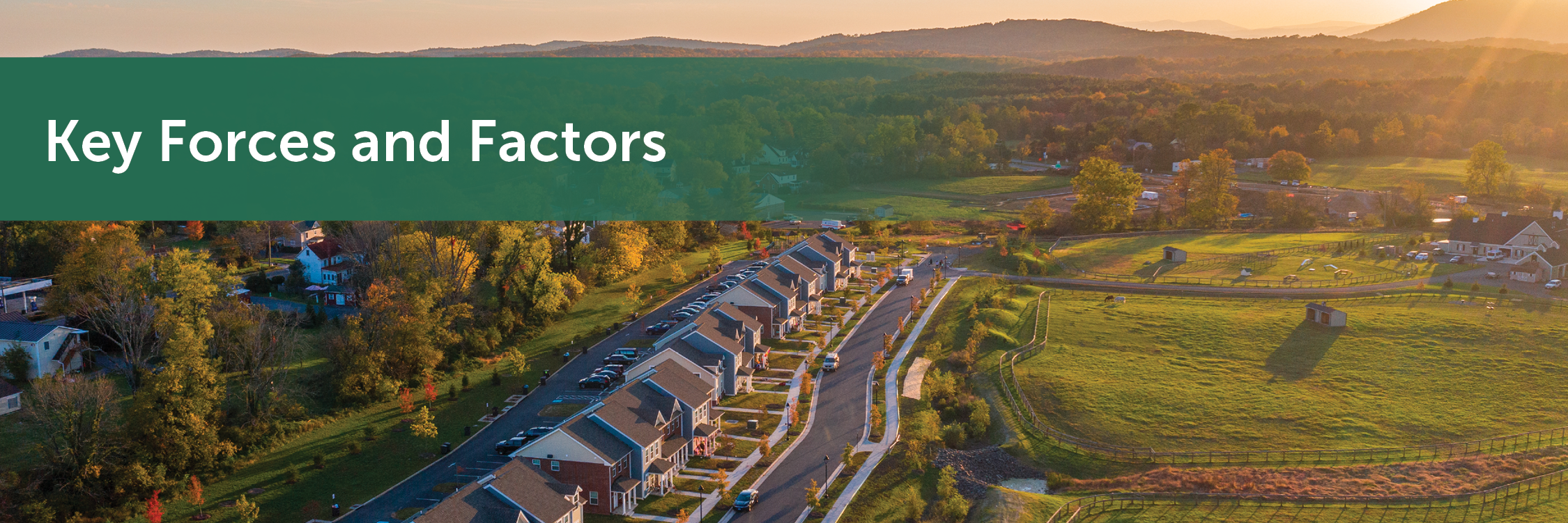
Throughout our strategic plan process, PEC staff and board considered a variety of social, technological, economic, environmental and political factors influencing trends in the Virginia Piedmont, and considered ways PEC might respond or adapt moving forward:
Real estate development pressure in the Virginia Piedmont, already significant, is likely to grow.
PEC will strengthen our capacity for local planning and smart growth advocacy. We will continue to oppose sprawling development and large road projects that pull resources and investment away from unmet needs in existing communities. We will advocate for redevelopment, infill, and housing, including affordable housing, in our cities, towns and suburbs to make them more walkable, livable and vibrant. We will challenge development in rural areas that impacts the conservation values we are committed to protect.
Increased electricity demand, tied to explosive growth in data centers, is causing a new round of electric infrastructure expansions. This growth is also exacerbating pressure to convert greenfield land to utility-scale solar.
Since issues related to energy policy and siting of energy infrastructure play out at both the local and state level, we will build our staff capacity with a particular focus in these areas. Recognizing that data centers are a modern reality, PEC is committed to researching the matter further, working with partners, opposing bad planning and siting decisions, and highlighting the choices and tradeoffs affecting Piedmont communities. Given that utility-scale solar will be a critical part of Virginia’s clean energy transition, we are advocating for improvements to the permitting and siting process, including best practices for design and construction of facilities and protection of soils and other conservation resources. We are also pushing for expanded incentives and use of solar on parking lots, commercial and industrial rooftops and other developed areas.
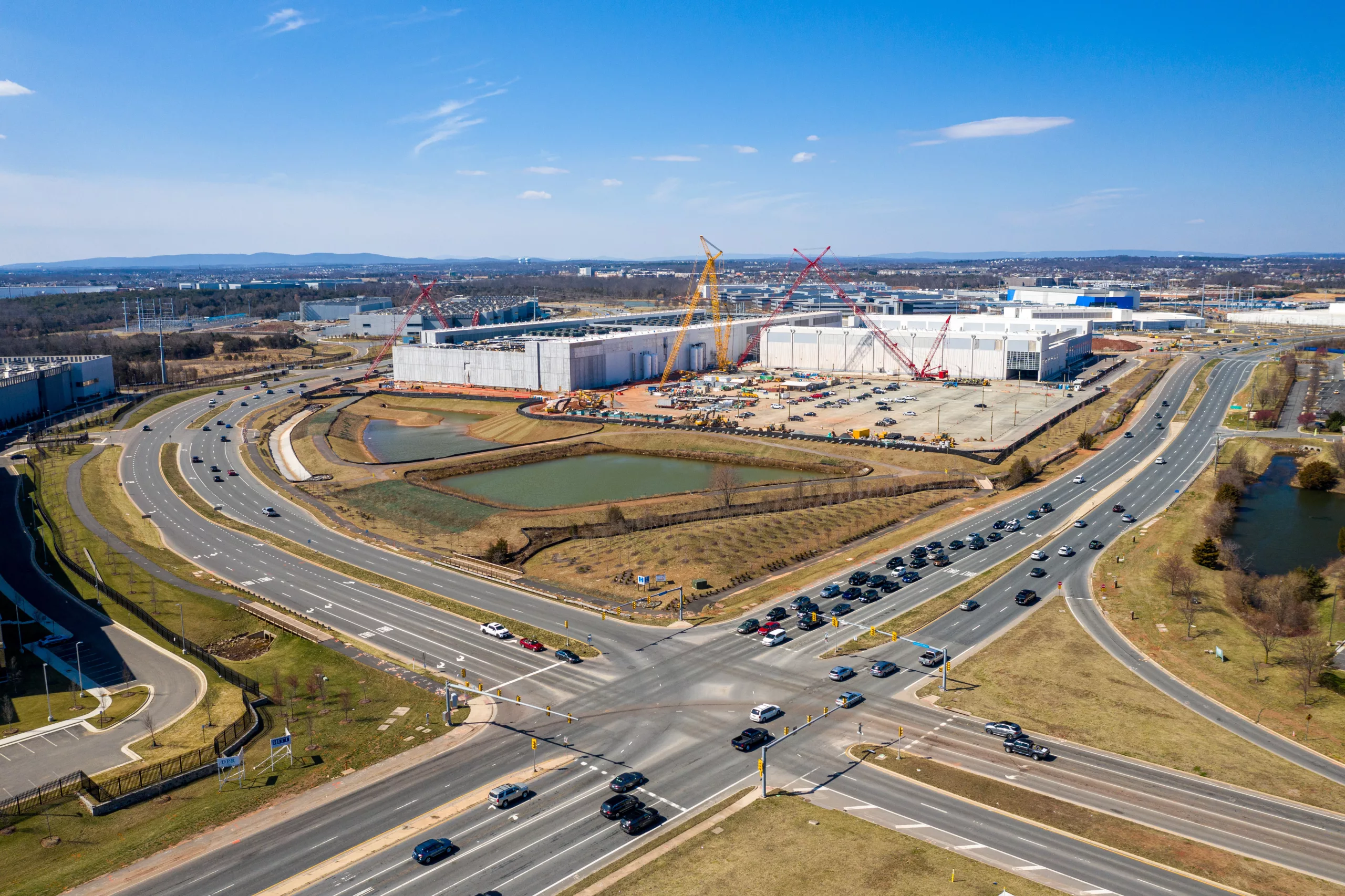
Public policy objectives like clean water, biodiversity, food security, and climate change mitigation and resilience are increasingly dependent on accelerating the pace of land conservation.
New tools and expanded funding for land conservation and cultural landscape protection are more critical now than ever before. By emphasizing the broad public benefits of land conservation, PEC will advocate for additional resources for land protection at the local, state and federal level. We will also strive to significantly increase PEC’s conservation funds, which will leverage public dollars and accelerate conservation.
The opportunity to enjoy this place we love to the fullest is not equitable for everyone, including access to nature, housing and land ownership.
We will advocate for conservation and smart growth in the Virginia Piedmont that is increasingly inclusive, addressing housing, open space and healthy food needs, and expanding public access to the region’s rivers and lands. In order to be effective, PEC must forge stronger connections with all of its communities, including new residents and those we haven’t reached before. In addition, we are working to ensure that our staff and board, and the partnerships we rely on, better represent the diversity of the region.
The impacts of global climate change, already being felt in our communities, will intensify.
PEC will continue its leadership on such local- and state-level climate solutions as reducing vehicle miles traveled, increasing carbon sequestration through land conservation and restoration, implementing sustainable agricultural best management practices and pursuing a clean energy future. In addition, we are ramping up our role in resilience planning to ensure our counties develop and implement strategies for adapting to climate change.
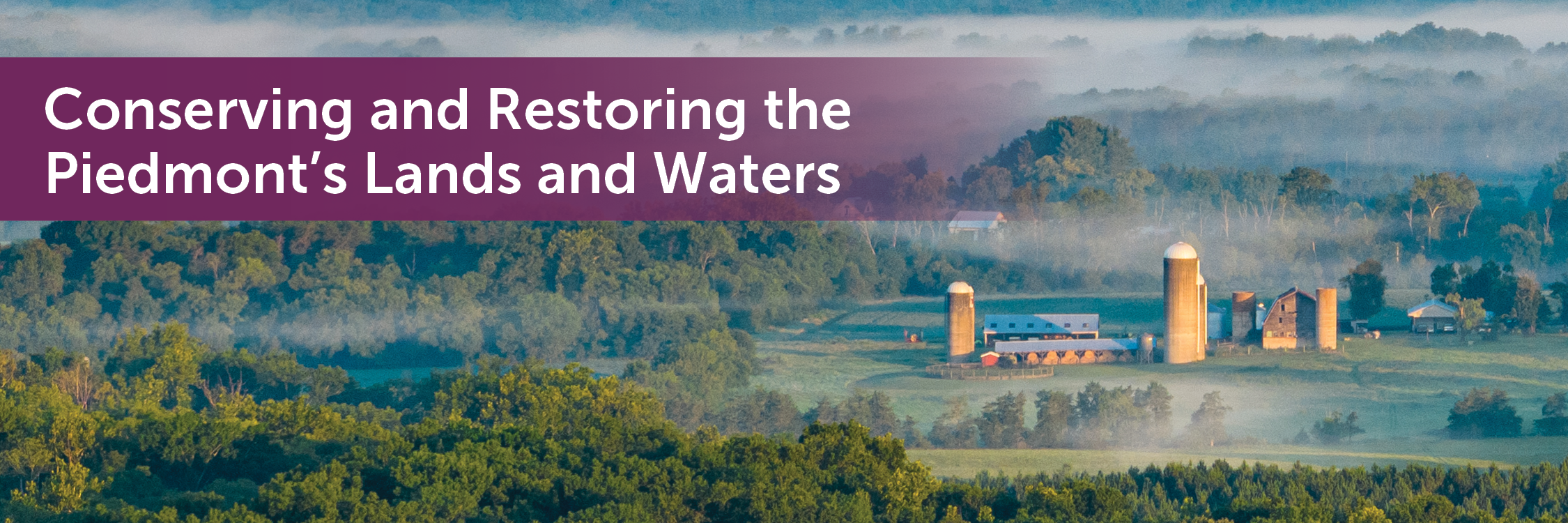
Virginia’s Piedmont is a unique place for residents and visitors alike, with its exceptional natural resources, productive farms and forests, and a landscape steeped in history. The abundant public benefits of these irreplaceable resources are multifaceted — individual, regional, global, economic, ecological, recreational, climatic.
The Piedmont’s natural lands strengthen our quality of life and sense of place, contributing immeasurably to overall human health and well-being. Full of trees and vegetation, wetlands, streams and rivers, the region’s natural lands filter pollution from the air we breathe and the water we drink. They absorb carbon from the atmosphere, produce oxygen, and provide natural protections against flooding and storm events. They are also the foundation for functioning ecosystems and a refuge for biodiversity. The Piedmont’s farmland promotes local food security, and its rivers and streams sustain the fisheries on which commercial and recreational fishing industries depend. Farming and forestry together are Virginia’s largest industry, while hundreds of thousands of tourists come to experience our natural wonders, scenic views and historic places.
As of 2021, more than 433,000 acres of the region’s natural areas, working farms and forests, and beautiful open spaces are permanently protected by conservation easements. Such immense achievement has been made possible by the leadership role PEC has played in establishing and upholding the state’s conservation policy framework and the work we do as an accredited land trust. That work involves navigating easement transactions, educating landowners and conservation professionals, and building strong partnerships and stewardship initiatives that promote water and soil health, wildlife habitat restoration and the productivity of our agricultural lands.
Still, in light of growing development threats and land conservation’s critical role in combating the impacts of climate change, much more land must be protected. Going forward, PEC has established four strategic pillars within our conservation and restoration focus:
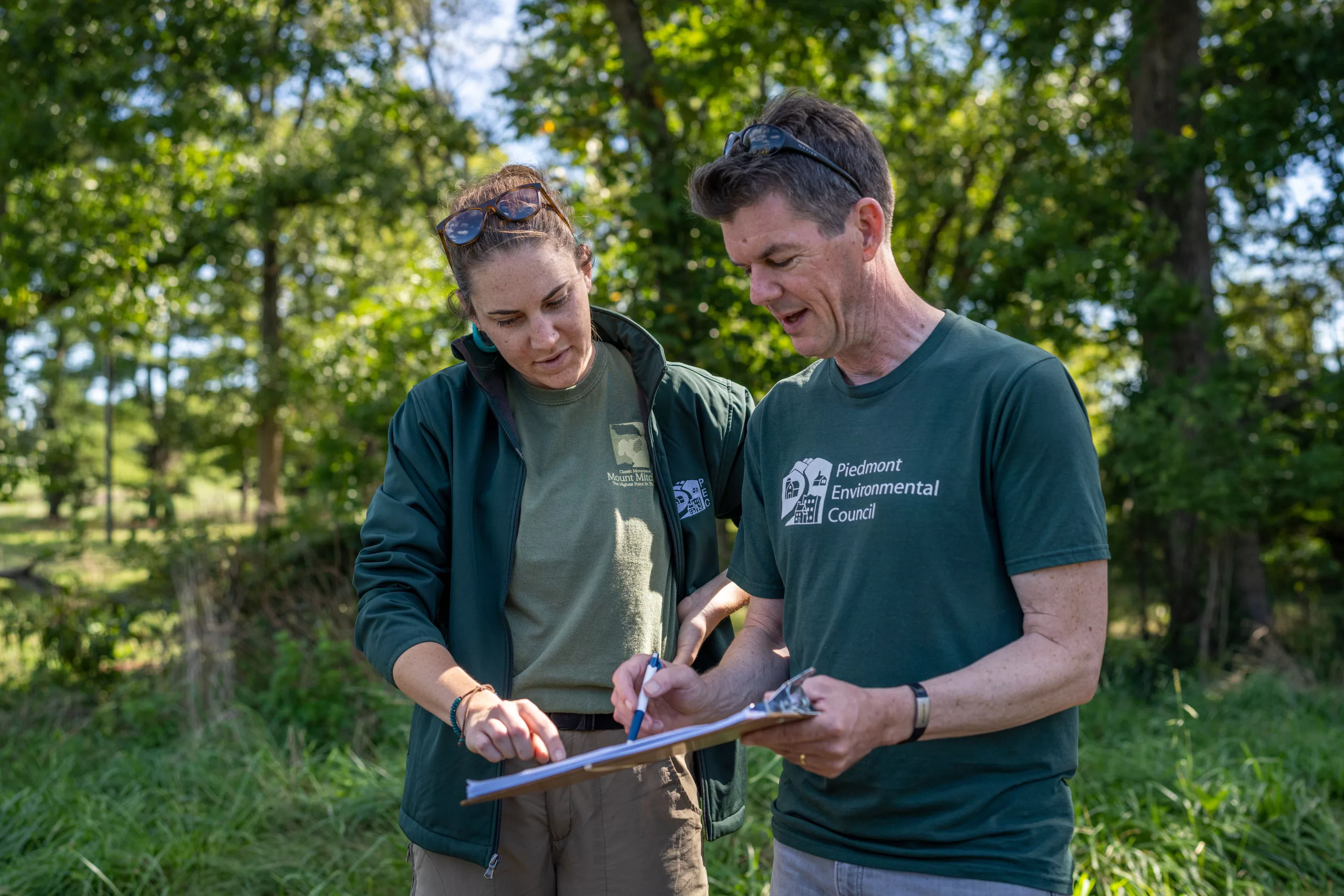
Accelerating Land Conservation
We are working toward an ambitious goal of protecting an additional 100,000 acres of farm, forest, cultural and other priority open spaces in our region by the end of 2030. With the achievement of this goal, 30% of the Piedmont’s lands would be permanently protected, reaching a critical threshold for sustainability, biodiversity and climate resilience. Longer term, PEC has a goal of more than one million acres protected, representing about half of the land in our nine-county service area. We believe this is achievable through sustained partnerships with landowners and preservation allies and through the use of a combination of public and private conservation tools.
This land conservation effort will require continued advocacy for policies and funding mechanisms at the state, local, and federal level that make land conservation feasible and accessible to landowners of all income levels. It will also rely on a robust outreach effort to local landowners and potential conservation partners. PEC’s multifaceted outreach and technical assistance helps landowners understand their conservation options and make informed decisions about the future of their land. Our institutional commitment to landowner engagement over a sustained period has resulted in a familiarity with conservation in the region that is unmatched elsewhere in Virginia. Along with partners, we are committed to growing this outreach in the future. In addition, we will further increase PEC’s capacity to hold conservation easements directly and maintain standards and practices that ensure land is protected forever.
Ensuring Clean Water
Water is the lifeblood of our land, communities and economy. From the headwater streams of Shenandoah National Park to the Chesapeake Bay, water flows through all of our land. PEC is committed to the Chesapeake Bay Watershed Agreement, which envisions an environmentally and economically sustainable Chesapeake Bay watershed.
Over the next five years, we will focus on activities that reflect the essential nexus between land conservation and improving water quality. PEC will collaborate with landowners, nonprofit organizations and public agencies to protect and restore stream-side tree buffers, install stream fencing and alternative watering systems for livestock, and restore healthy soils to curb erosion. Our longstanding relationships with rural and agricultural landowners make us a trusted messenger and partner with Soil and Water Conservation Districts and other agencies that administer funding programs for voluntary water quality improvements.
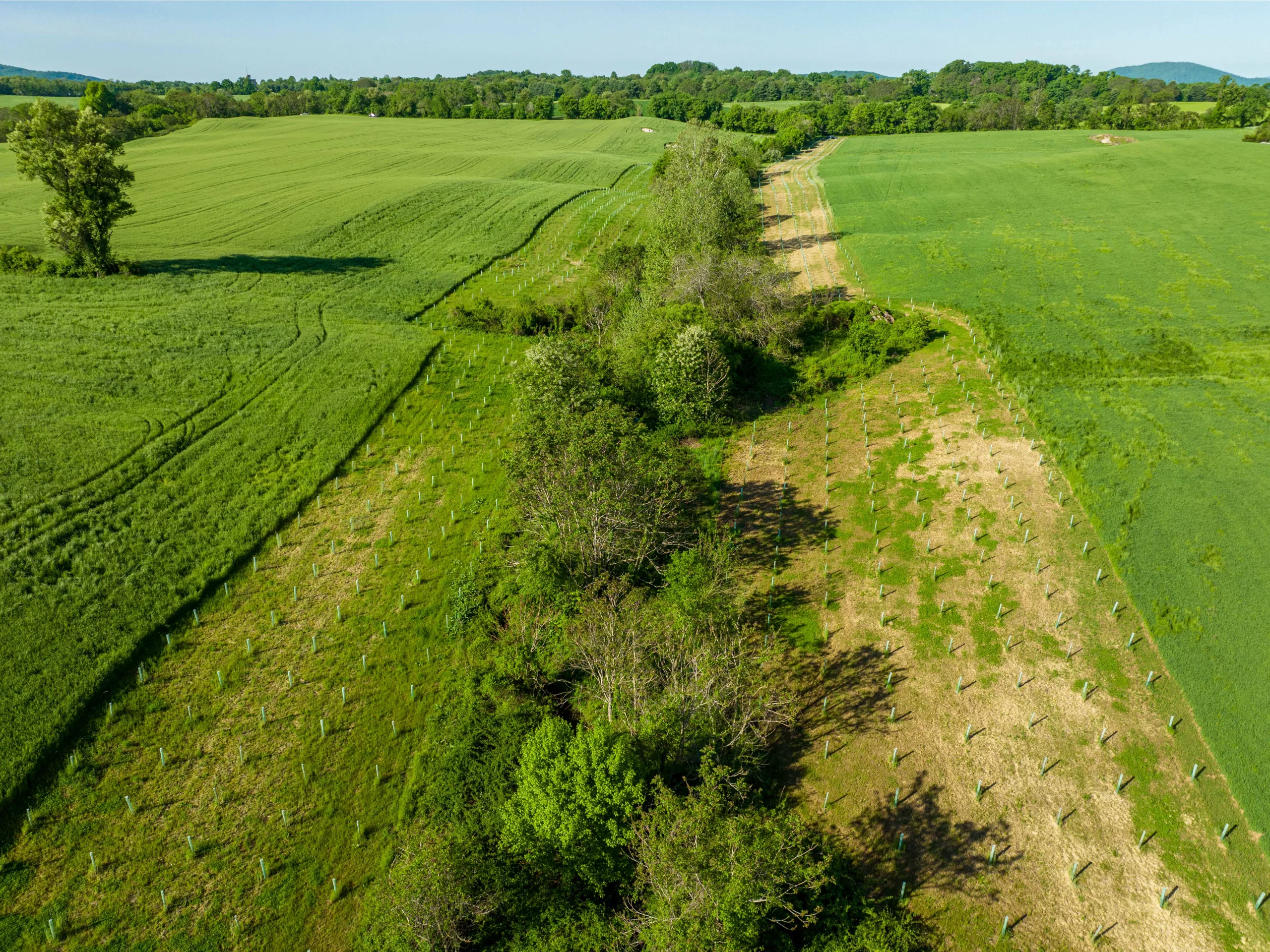
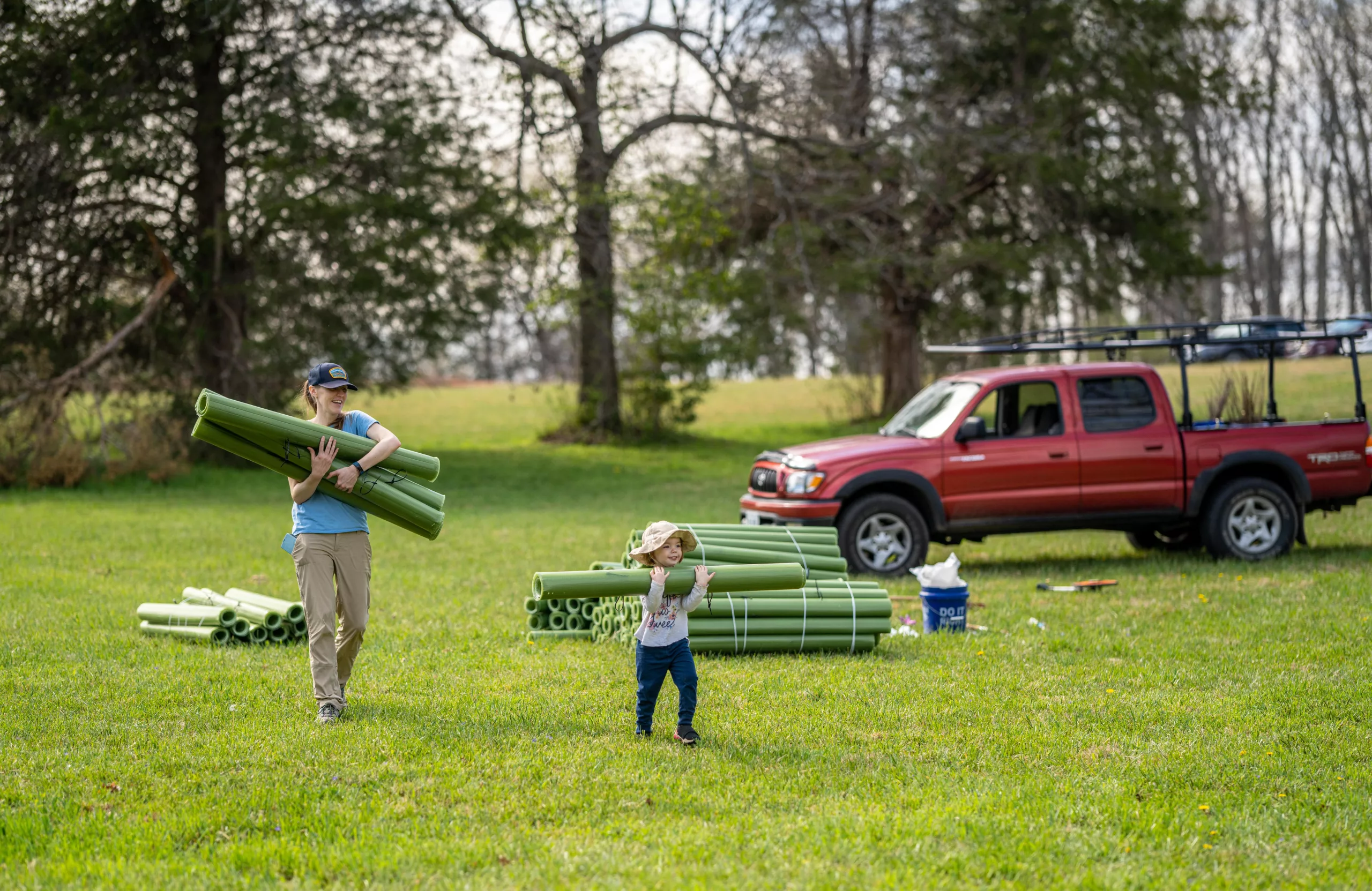
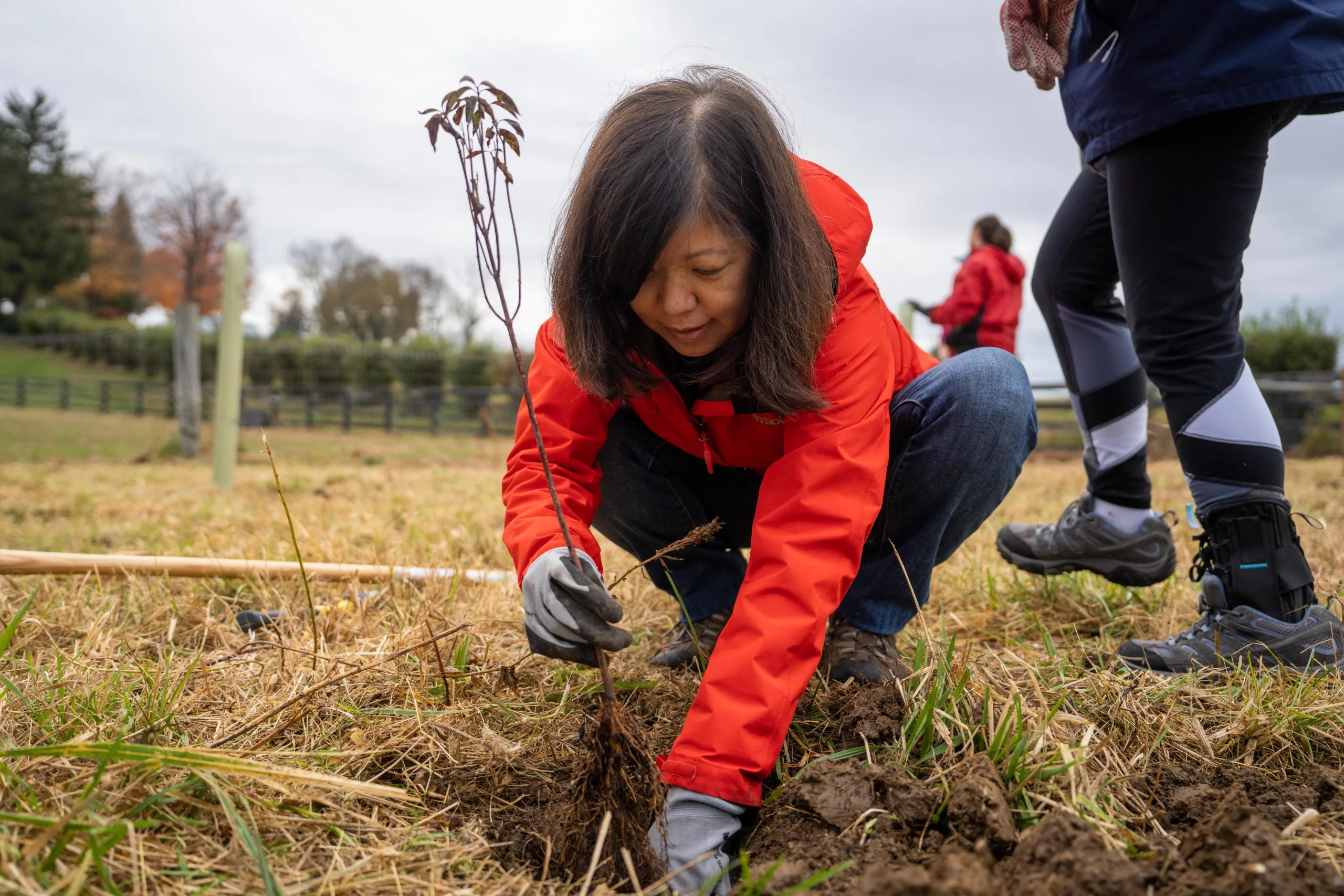
Enhancing Wildlife Habitat
The conservation of land will remain a critical tool we employ to protect and improve biodiversity of native flora and fauna. Additionally, PEC will amplify our work with landowners on land management practices that create native wildlife and pollinator habitat and foster well-connected plant and animal habitat corridors, from urban and suburban communities to wilderness areas in the rural Piedmont. We will expand partnerships with agricultural landowners to adapt their farming and haying practices to restore grassland habitat for native birds. PEC is well positioned to stem the decline of grassland birds, through our longstanding relationships and level of credibility with rural landowners in the Piedmont. This work will also include a focus on forest land, notably the large forest blocks along the Blue Ridge that provide critical habitat and water quality protection around Shenandoah National Park and the Appalachian Trail.
Expanding Public Access
The need for more, well-distributed public access to parks and green spaces throughout the Piedmont became manifest during the global pandemic, when residents sought respite and renewal in natural areas, parks, and trails like never before. Research shows that access to nature improves not only individual health, but also the well-being of communities.
Land conservation, which requires expertise and familiarity with complex real estate transactions, is the key to opening up new trails, parks and other conserved spaces for all people to see, experience, and enjoy. Expanding people’s access to conserved and nature-filled places – whether in urban, suburban or rural areas – strengthens public support for increased investments in conservation.
Using the Old Carolina Trail, Fifeville Trail, the Route 50 corridor, and the Rappahannock River Water Trail as models, we will develop, support, and pursue a regional strategy for fostering more public access and connectivity throughout our region. Informed by the Virginia Outdoors Plan and other resources, conservation that builds and strengthens opportunities to connect people and natural habitat to and between the region’s publicly-accessible parks, natural areas and waterways will be a focus.
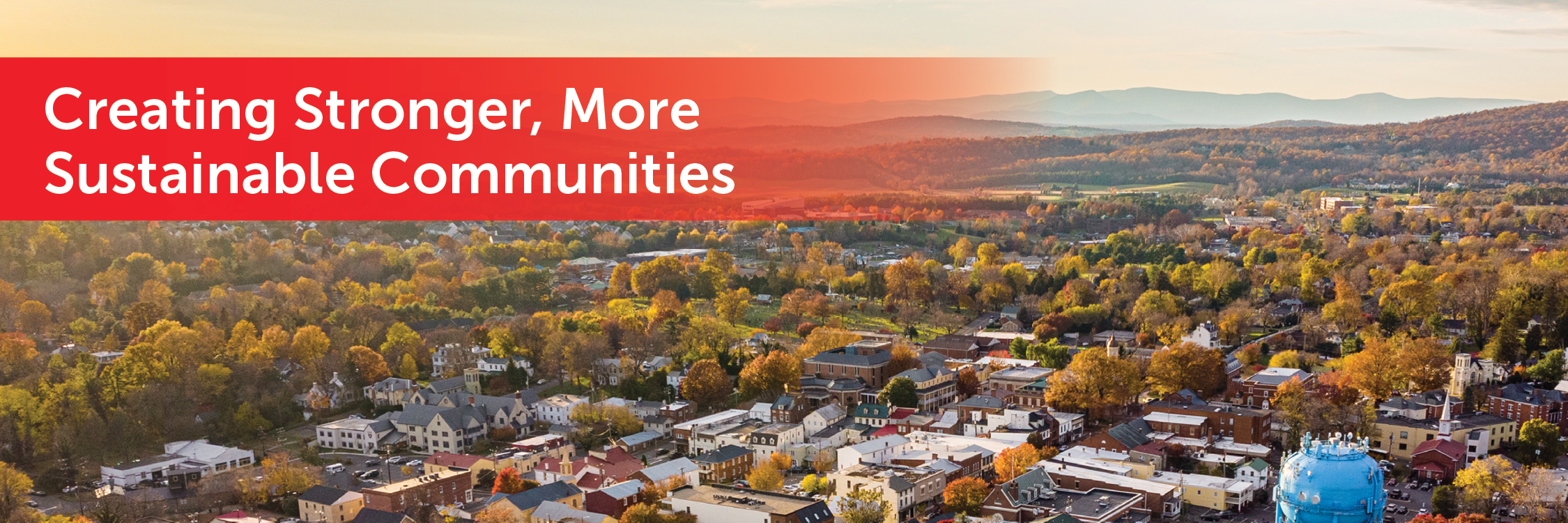
A thoughtful approach to land use planning, paired with decision making that balances growth and development with natural and cultural resource protection, is vital to maintaining a healthy and vibrant Piedmont region. That is why, for each of our nine counties, PEC has professional staff who delve into development proposals, zoning, and comprehensive plans in order to advocate for conservation and smart growth. This staffing model allows us to participate locally at planning commission and board of supervisor meetings, join regional planning exercises, and advocate for sound land use policy at the state level. In these ways, we are able to weigh in directly and help residents engage effectively.
As ever, the Virginia Piedmont is surrounded by dynamic regional economies and subject to a dizzying array of development pressures. These run the gamut from exurban residential development to a growing number of industrial development proposals for data centers, distribution centers and power generation facilities. All of these land use pressures go hand-in-glove with proposals for new transportation and energy infrastructure, such as highways and electric transmission lines, that have potentially grave impacts on the rural Piedmont and our villages, towns and communities. Given these realities, PEC’s land use work is necessarily both proactive and reactive, in the following ways:
Planning for Now and the Future
When local residents express a shared vision, it becomes a map for conservation efforts — a defense against speculative interests and a guide to creating better, stronger communities. PEC keeps residents and community groups informed about local land use plans and proposals as they go through local processes. We are an active participant in comprehensive planning reviews to help communities develop and realize their goals and visions. In all of this, we advocate that smart growth policies, programs, and investments be enshrined in comprehensive plans, budgets, zoning codes, etc.
As Piedmont region communities consider the future, it’s also imperative to incorporate resilience planning in the face of climate change. Flooding, intense heat, and increased vulnerability to drought are among the top impacts our governments must prepare for and actively address. We will urge Piedmont localities to integrate nature-based solutions and smart growth strategies within their comprehensive plans, building resilience and providing multiple ecosystem and community benefits. While doing so, we will advance equity and justice and commit to working with residents and community organizations to amplify the voices of those most affected and champion their needs.
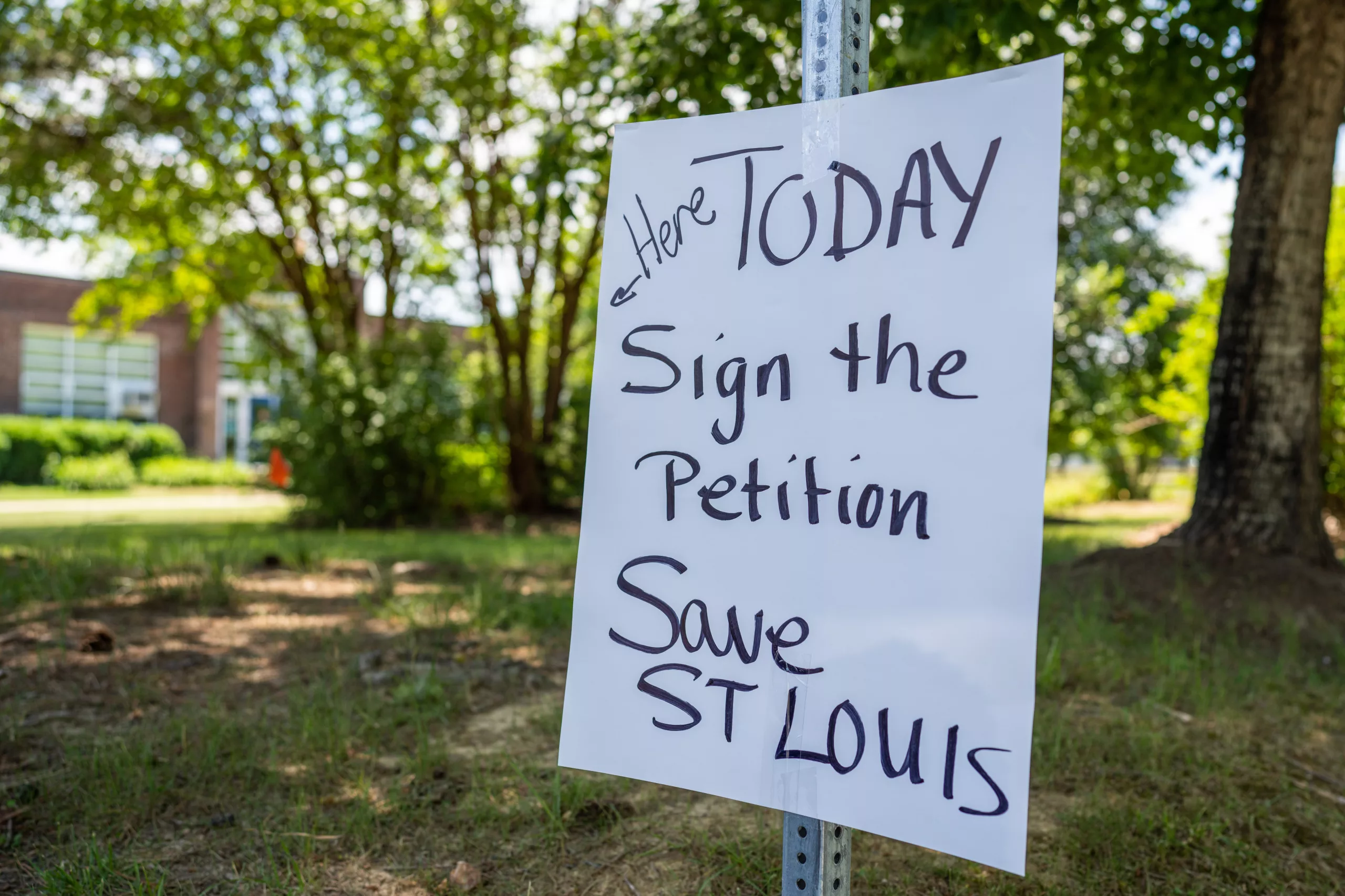
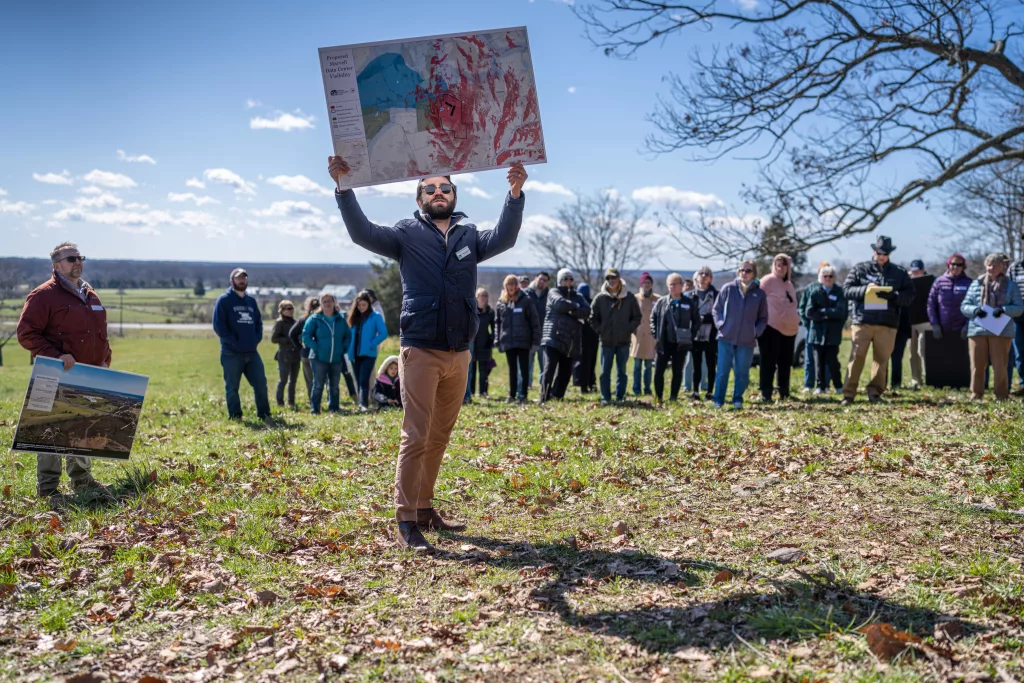
Fighting Bad Projects and Incompatible Land Uses
From the ill-conceived “Disney’s America” proposal, to uranium mining, to countless sprawl-inducing highway projects and transmission line proposals, PEC has never shied away from a fight. Our capacity to organize campaigns and coalitions to stop bad projects and offer better alternatives will only become more needed, as the Piedmont faces a surge in development pressures that is unlikely to abate any time soon.
Our work is this area is grounded in local land use expertise and a commitment to civic engagement. We serve as a vital ally for people when the places and natural resources they care about are threatened, directing grassroots energy into effective strategies. PEC’s communications and outreach team work with our field staff, using sophisticated mapping, advocacy, and multimedia tools, to engage with the public. Many committed activists and highly regarded experts in a wide range of topics live within our communities, and their knowledge and talents help inform and enhance our work. This collaborative approach, coupled with a long memory and regional perspective, gives PEC the ability to take on even the most overwhelming threats.
Improving Livability and Strengthening Communities
Land use policies are not just aspirations for the future; they translate into everyday experiences for residents. Can residents afford to live in a place that is close to jobs and other opportunities? Can they walk to their favorite restaurant or shopping center? Where can they go to enjoy the outdoors and how long will it take them to get there? Can they buy their food from a local farm? Is the water safe to drink? Do they have to sit in hours of traffic to get to and from work? PEC helps communities participate in decision-making processes and access funding sources to improve their quality of life for the short and long term.

PEC will pursue policy work and project implementation that helps people on the ground, where they live. We expand public access to waterways and greenspace and enhance connectivity through new bike lanes, sidewalks and trails. We save beloved places at risk and reimagine their use, encouraging appreciation of historic and cultural resources. We advocate for a range of housing options, including more affordable housing, guided by principles of smart growth, and other positive changes to make communities more sustainable and equitable.
Our work, largely centered in PEC’s nine-county region, is in common cause with organizations and communities outside of our service territory. We are an active participant in the Virginia Conservation Network, which includes over 150 groups and organizations across the Commonwealth, committed to building a powerful, diverse, and highly-coordinated conservation movement focused on protecting our Commonwealth’s natural resources. The critical work of the Coalition for Smarter Growth, a division of PEC, advances the development of livable, walkable communities oriented around transit, trails, and other transportation infrastructure and amenities in the greater Washington D.C. metro region. PEC is also an active partner with other coalitions at the regional, statewide and national scale, learning from others and sharing our experience and expertise.
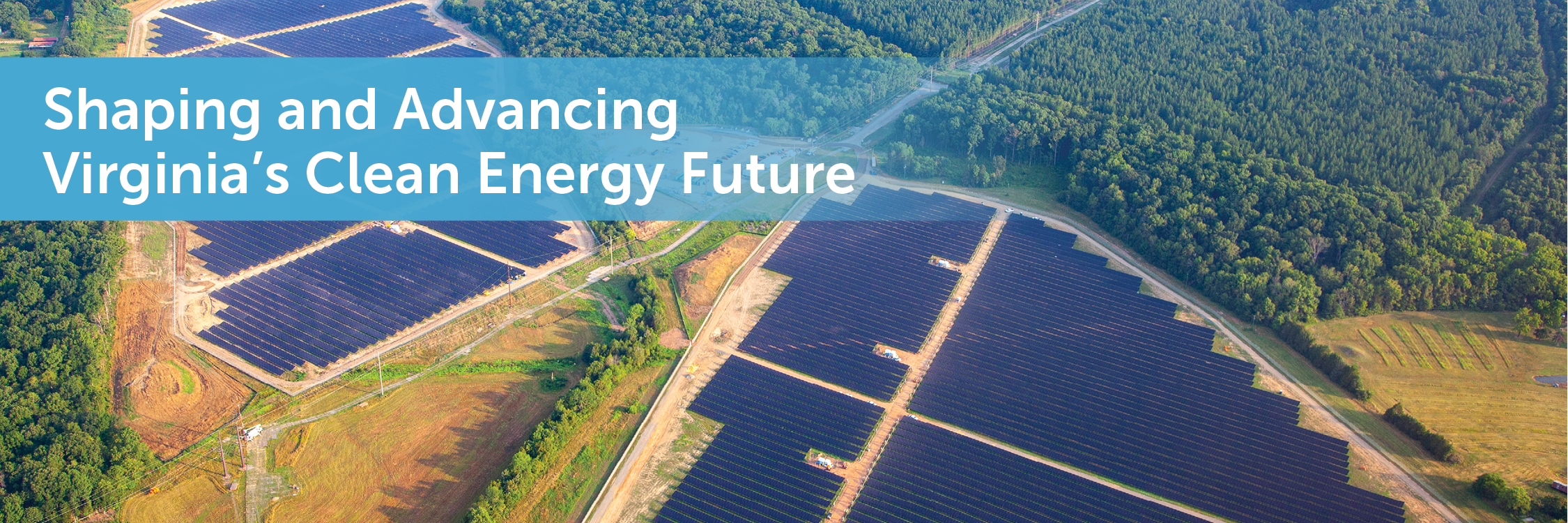
For the future of our planet, it is imperative that we transition rapidly to clean energy. The good news is that Virginia has taken a major step toward a clean energy future by setting ambitious targets for ramping up renewable generation. The Virginia Piedmont has a critical role to play in this transition, because much of it is expected to come via utility-scale solar in rural areas. As the use of solar energy expands, we will advocate for projects and associated infrastructure that are planned and sited in a way that is sensitive to the Piedmont’s most critical natural, cultural and agricultural resources.
Zooming out, PEC would like to see an energy system that is smarter, more efficient and better accounts for the negative externalities arising from the choices we make about energy consumption, generation, transmission and distribution. We’d like a more distributed system that is less reliant on distant generating sources and incorporates a mix of local renewable power — customer owned, community based and utility scale. We’d like to see a much more sincere effort to locate solar generation within the built environment, close to the highest levels of demand. A distributed grid reduces environmental impact and results in a more resilient and reliable grid. And recognizing we are at the beginning of an energy transition, there is an opportunity to rebuild our energy system in a way that is just and fair to all Virginia residents and ratepayers.
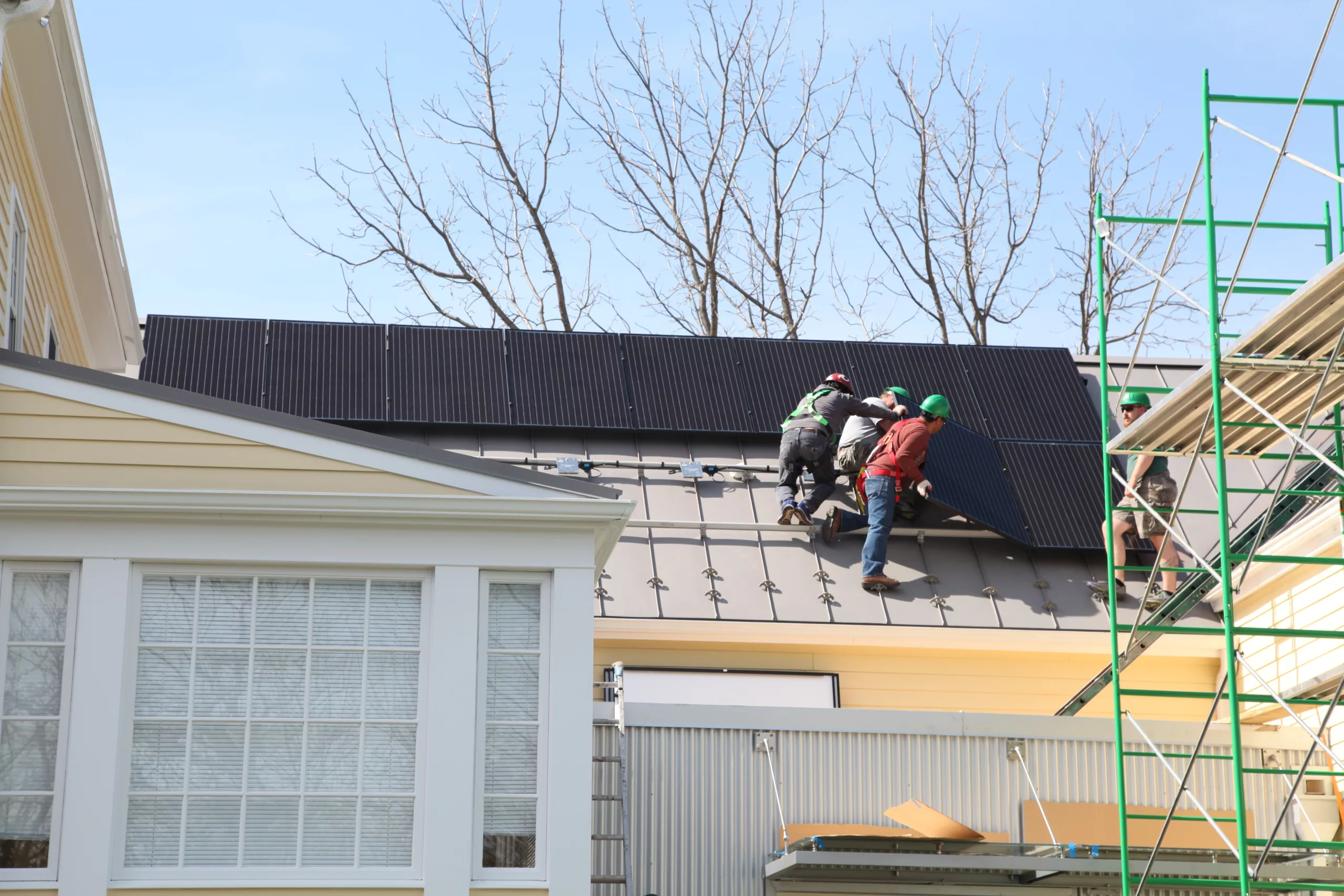
We believe PEC’s on-the-ground perspective, dealing in both policy and its direct impacts on the communities we serve, to be invaluable in the conversations about energy taking place at the local and state level. PEC is recognized for its expertise in local land use planning and policy. Going forward, we will expand our staff expertise related to energy policy and siting, given its enormous implications for local land use, and build out a more comprehensive energy platform.
Multiple new and ongoing trends impact our approach to this work:
The explosive growth of the data center industry represents a major challenge to achieving a clean energy future. Data center development in our region and Northern Virginia has been accelerating for years, outpacing anywhere else in the world. Data centers now account for about 20% of Dominion Energy’s sales in Virginia. Data centers represent the only growing sector of electricity demand in Virginia, with demand from data centers projected to make up the bulk of future demand growth (Commonwealth of Virginia, 2021).
The accumulation of data centers in such a relatively small area, and the corresponding demands on our electric grid and reliance on polluting back-up diesel generators, will have undeniable implications for our farmlands, forests, historic resources, wildlife, communities and families. Virginians are increasingly being asked to subsidize new transmission infrastructure and renewable generation to meet the massive energy demand of private corporations, like Amazon Web Services and its subsidiaries, undercutting progress on a green energy future built to serve our homes, local businesses, transit and vehicles.
The size and scope of what we are planning for will have significant land use implications. On average, utility-scale solar requires roughly seven to ten acres per megawatt produced. Depending on what upfront assumptions are made, Virginia’s transition to a clean energy future will require somewhere between 96,000 acres of utility-scale solar to upwards of 1.3 million acres (Commonwealth of Virginia, 2021).
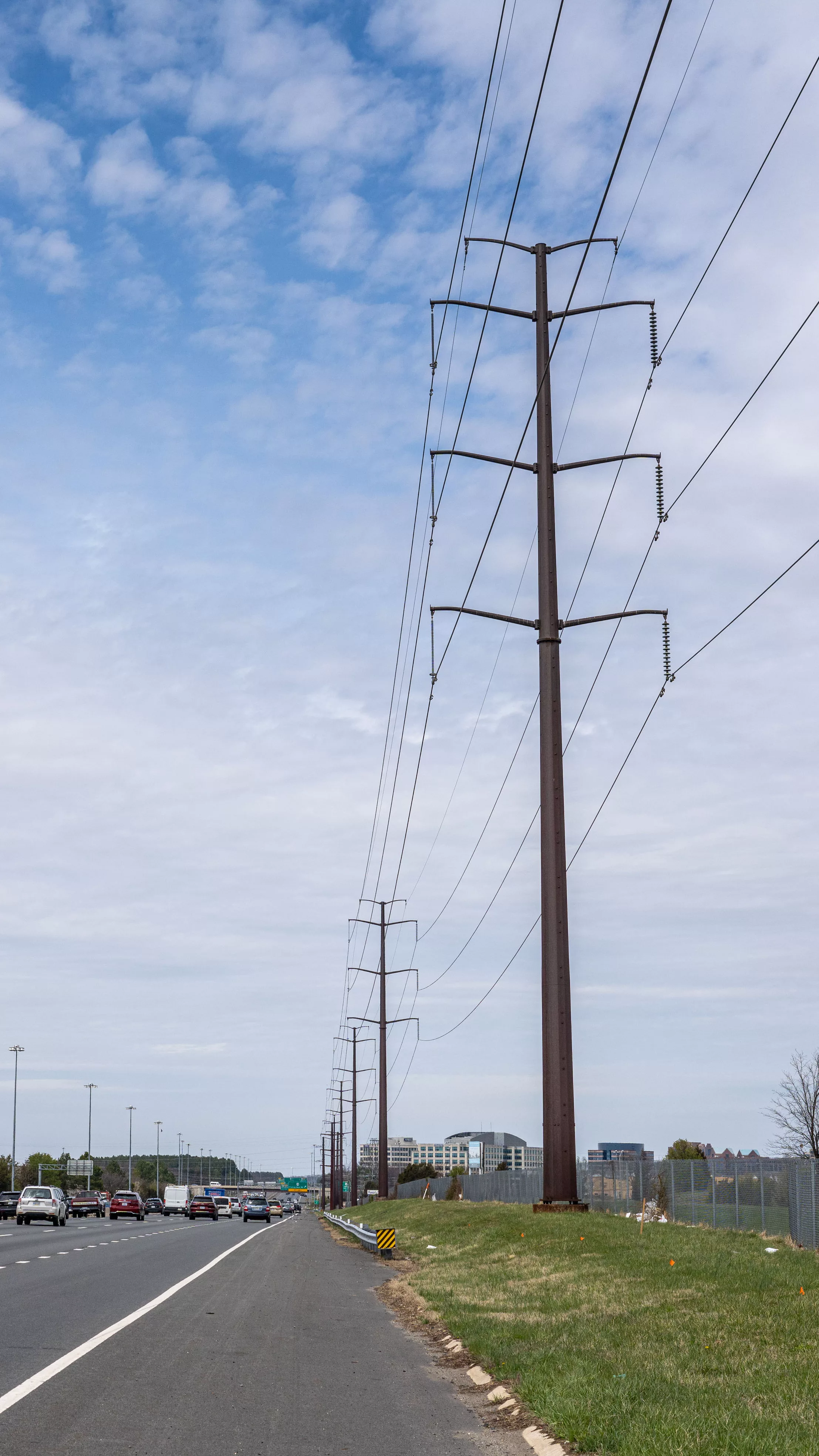
Where and how we site utility-scale solar needs improvement. In Virginia, current utility-scale solar installation practices involve massive grading and compaction, dramatically impacting the natural resources and ecosystem function of selected sites. In 2021, researchers found that 58% of utility-scale projects occurred on forested lands, nearly 25% occur on cropland and 7% on pasture land (Berryhill, 2021). This trend exists despite the availability of brownfields, abandoned mining land, transportation and transmission corridors, and significant space within the built environment. In both siting and installation, Virginia has not required emerging industry best practices. PEC will play a vital role in pushing for a better approach.
There are renewed calls for dramatically expanded transmission and other infrastructure. The Piedmont’s location, just south of northeast electricity demand centers, and east of centralized power generation sources in the Midwest, make it a likely target for future long-distance transmission line projects. In addition, Virginia’s reliance on power generation sited in rural areas, and active recruitment of data centers, will mean the Piedmont sees an increase in proposals for new substations, new transmission lines and upgrades and expansions of existing rights-of-way. From our groundbreaking campaigns on the PATH, TrAIL and other transmission line proposals, PEC is a recognized national voice on interstate transmission policy. We will bring this expertise to bear in addressing the complex decisions ahead on transmission capacity and its impacts on the Virginia Piedmont.
Berryhill, Aaron R. “Utility-Scale Solar in Virginia: An Analysis of Land Use and Development Trends.” Professional Plan Capstone, Virginia Commonwealth University, 2021. https://scholarscompass.vcu.edu/murp_capstone/41/.
“Modeling Decarbonization: Report Summary and Policy Brief for Virginia Governor’s Office Administration and Policymakers (Chapter 1194, 2020).” Commonwealth of Virginia, 2021. https://rga.lis.virginia.gov/Published/2021/SD17/PDF
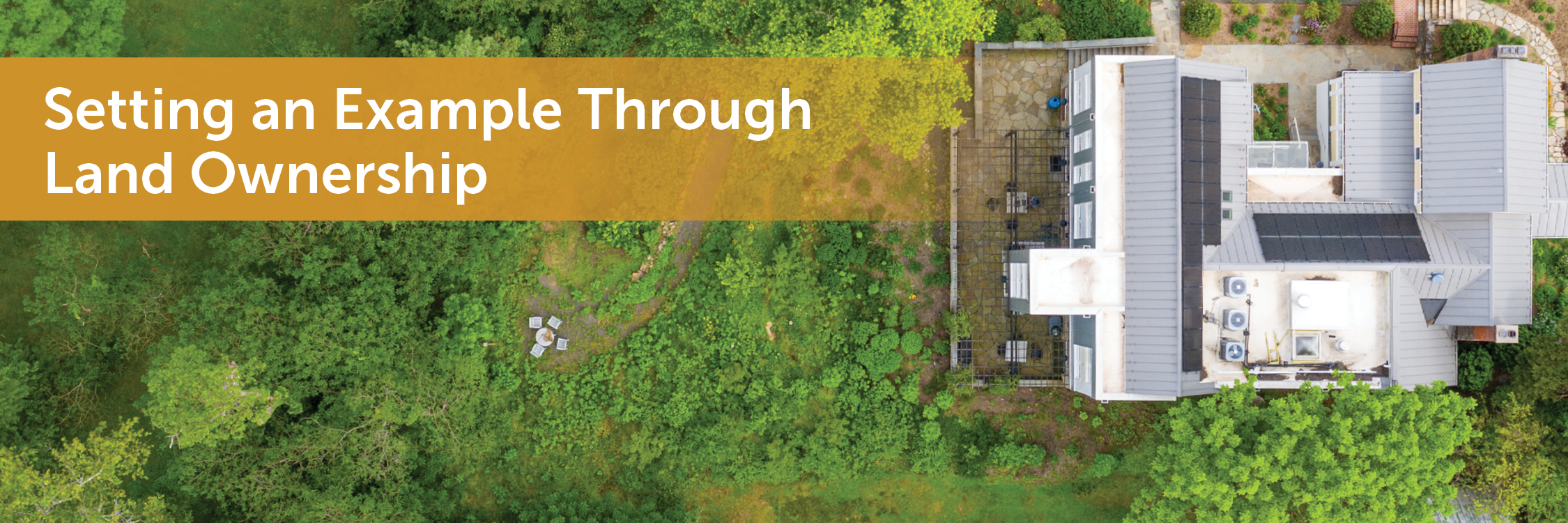
PEC has owned our headquarters office in Warrenton since 1993. And from time to time, when a conservation opportunity and community support has aligned, PEC has stepped into the role of landowner in other locations throughout the region.
Often our ownership of a property is for the short term, such as in cases where we received gifts of land and put conservation protections on the property prior to an eventual sale. Or, in some cases we acquire land and then transfer ownership to a local government or government agency to help complete a missing trail link or extend the boundary of a park. Other times, PEC has become an owner for the long term, as in the case of our Roundabout Meadows property in Aldie and the Piedmont Memorial Overlook in Paris. These properties help anchor conservation along the Route 50 Corridor and the Blue Ridge Mountains, two important public access points to the Piedmont region.
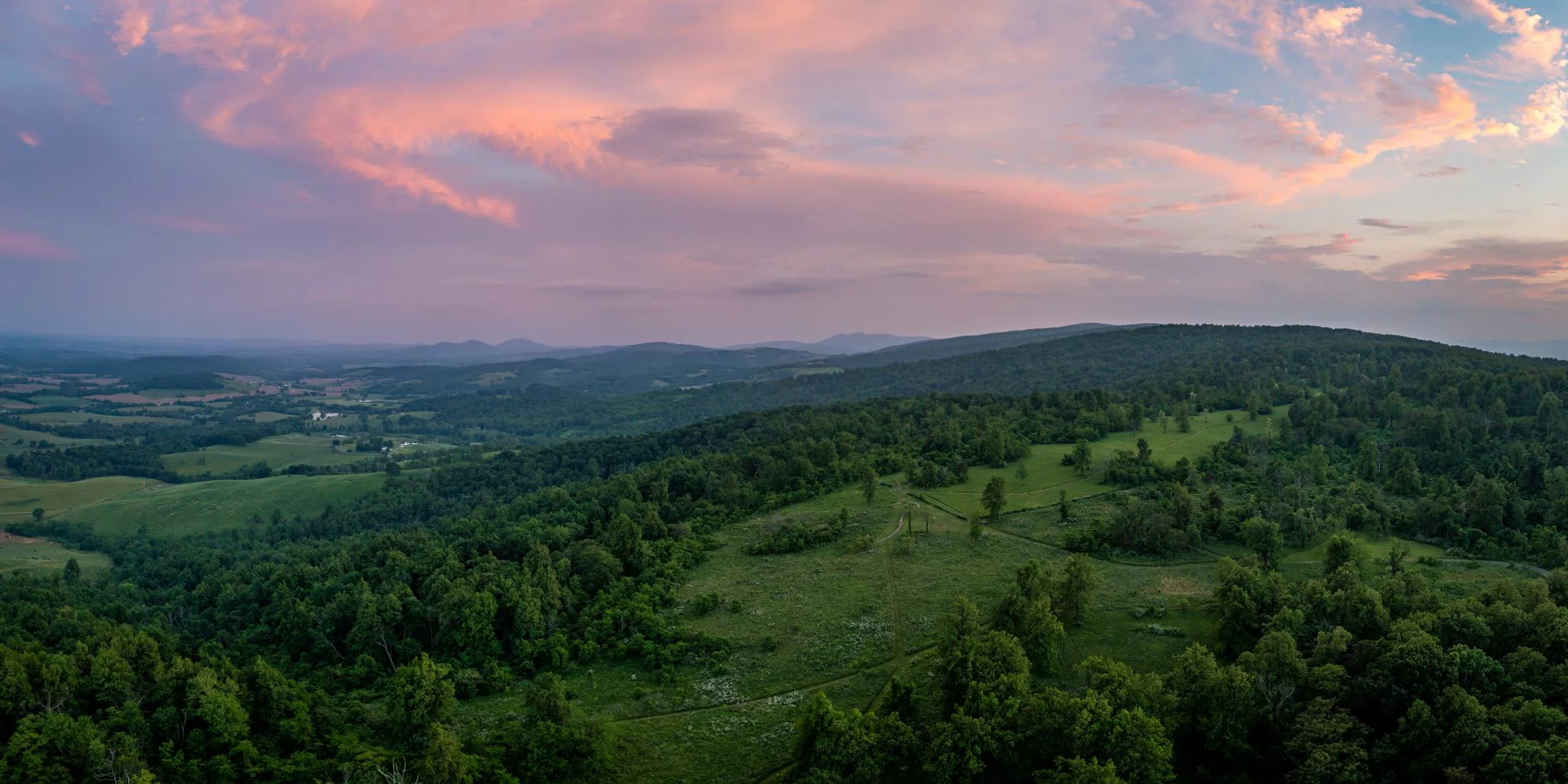
In every situation, PEC prioritizes protection or enhancement of the properties’ natural, cultural or historic value. As a landowner, we use our properties as a showcase for sustainable land management practices, such as native habitat restoration, soil health improvement, and livestock exclusion for water quality improvements. Whenever feasible, we facilitate or provide public access, inspiring a greater conservation ethic in our region and fostering an appreciation of nature and all of its virtues. Our properties have significant visitation and provide platforms for our work, demonstrating our vision, values and practices.
As we move forward, accelerating the pace of land conservation in this region could require PEC to play a more direct role in land acquisition, including as part of a “Buy, Protect, Sell” strategy. The Virginia Piedmont has numerous privately held, large acreage properties with high conservation value that are not protected by conservation easements. When PEC is aware that landowners plan to divest themselves of these properties, our principal action over the past decades has been to seek out private “conservation buyers” who are willing to acquire and protect the property. There is a significant track record of success using this strategy. Yet, for every success story, there are an equal number (or more) of missed opportunities, where no conservation solution could be found. The result has been development or threat of future development of these properties. To prevent loss of high value conservation opportunities, PEC will consider a more active role in acquiring and conserving land.
Case Study: Community Farm at Roundabout Meadows
In 2013, PEC acquired the 141-acre Roundabout Meadows property in Gilberts Corner as a donation from Roundabout Partners LLC. The acquisition capped two decades of conservation victories to preserve Gilberts Corner as the iconic gateway to the rural northern Piedmont of Virginia. With its highly visible location at the intersection of Routes 15 and 50 in Loudoun, Gilberts Corner and Roundabout Meadows offered an extraordinary opportunity to connect the 2 million+ nearby residents of northern Virginia with the Piedmont’s open spaces.
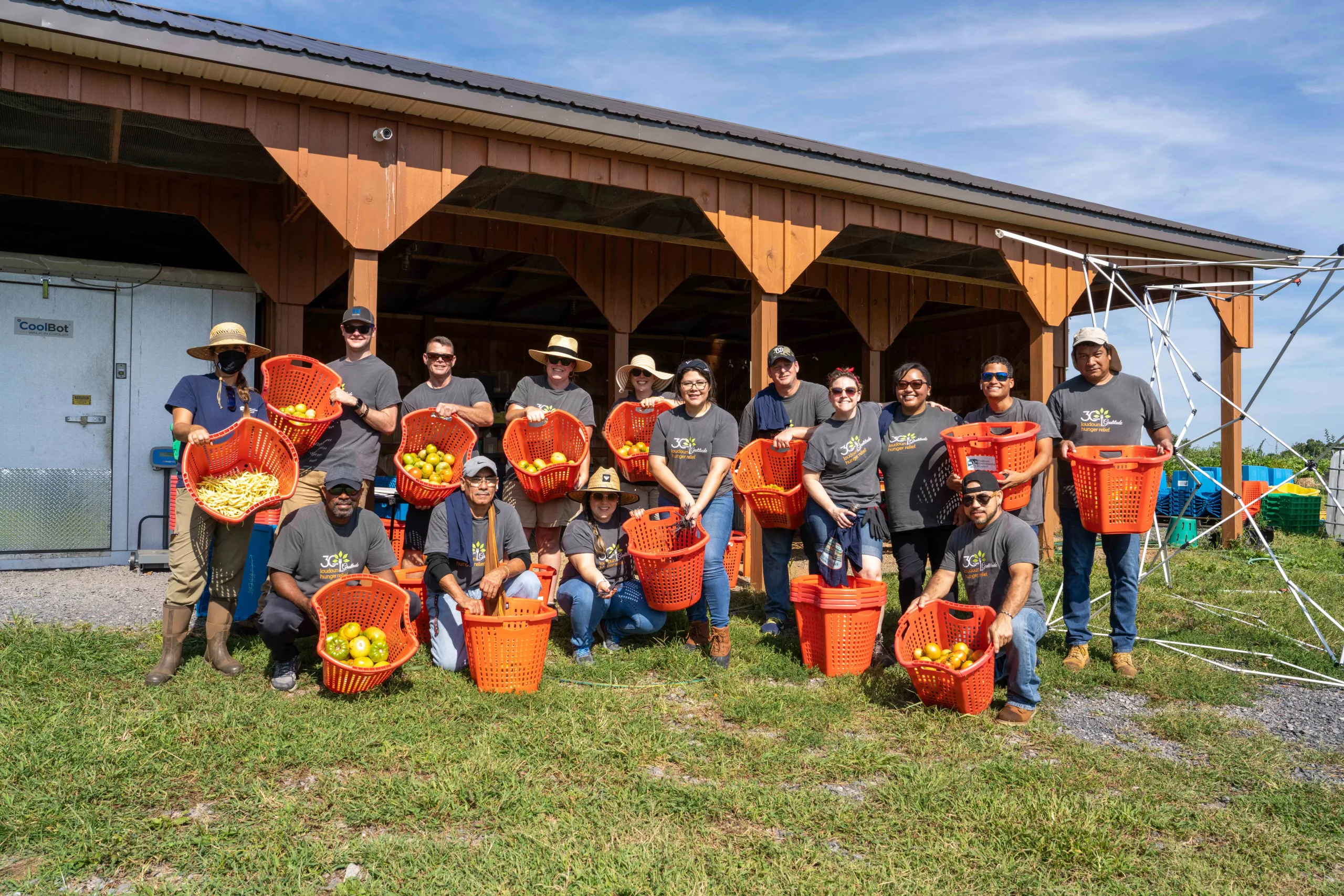
With this opportunity in front of mind, PEC has adopted and implemented a land management plan for Roundabout Meadows that focuses on public education and civic engagement. The centerpiece is the Community Farm at Roundabout Meadows, which engages volunteers from throughout northern Virginia and the Piedmont to grow fruits and vegetables for donation to food-insecure residents of Loudoun. Launched in 2019, the Community Farm now engages more than 1,000 volunteers and produces more than 35,000 pounds of healthy food annually.

The challenges and opportunities facing the Virginia Piedmont region are complex. PEC will employ a thoughtful and holistic approach to advance solutions. Depending on the issue at hand, PEC strives to take on one or more of the following roles:
- Serve as a thought leader. Communities throughout the Virginia Piedmont rely on PEC staff to do the research, attend the meetings, write comments and provide context and a vision for a better future.
- Shape public policy. As informed participants with an eye toward protecting natural resources and advancing sustainability, PEC staff engage at the local, state and federal level to shape public policy in a positive direction.
- Empower people to participate. Informed and driven by the latest research, strong relationships, and the personal passions of our staff, our on-the-ground, hands-on education, demonstration, and advocacy work inspires greater public participation.
- Encourage direct action. Individual and collective action is necessary to make change. We ask residents of the Virginia Piedmont and beyond to do the small stuff and the large stuff: volunteer, plant a tree, get rooftop solar, buy local food, practice sustainable land management, weigh in with elected officials, pursue a conservation easement. There are countless ways to make a difference today.
Crucial to all of this work are strong partnerships with individuals, communities and local, regional and national organizations. Our broad mission and vision allows us to bring together people with varied backgrounds and ideologies and to combine their energy, creativity and resources to achieve outcomes that would not otherwise be possible. We work with thousands of individual and organizational partners, both formally through coalitions and informally through day-to-day collaboration.
As we move forward, we are building on a strong foundation. PEC was conceived as a community-based organization, committed to a better, more sustainable future through planning, policy and direct action. Over the past 50 years, we have built a strong team of staff, board members, and partners across the region to deliver expertise, communications and resources to address the opportunities and challenges of the future. We look forward to building on that foundation to achieve the ambitious goals this plan sets forth. Key to that work will be making all aspects of PEC’s organization, programs, and communications more inclusive, equitable and representative of the many and diverse communities of our region.
Acknowledgments
We wish to express our appreciation for the many individuals who have played a part in the making of this strategic plan and in the endurance and achievements of The Piedmont Environmental Council since 1972. In particular, we thank our steadfast supporters and funders, our passionate and dedicated staff, and our stalwart board of directors, without whom this organization would not exist. We also thank the Piedmont Foundation, its board, and its funders for the generous support that has enabled us to respond nimbly and confidently to emerging forces of each era, those that have come before and those ahead of us. For ably guiding us through the strategic process that led us to this exciting new vision for our next era, we acknowledge and thank Bill Potapchuk and Cate Rodman of the Community Building Institute.
